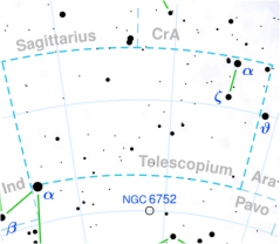Astronomy:HD 192827
| Observation data Epoch J2000.0 Equinox (celestial coordinates) | |
|---|---|
| Constellation | Telescopium |
| Right ascension | 20h 18m 55.97916s[1] |
| Declination | −47° 42′ 38.8042″[1] |
| Apparent magnitude (V) | 6.28±0.01[2] |
| Characteristics | |
| Evolutionary stage | AGB[3] |
| Spectral type | M1 III[4] |
| B−V color index | +1.47[5] |
| Variable type | suspected[6] |
| Astrometry | |
| Radial velocity (Rv) | −43.7±0.9[7] km/s |
| Proper motion (μ) | RA: +14.547[1] mas/yr Dec.: −3.934[1] mas/yr |
| Parallax (π) | 2.4785 ± 0.0638[1] mas |
| Distance | 1,320 ± 30 ly (400 ± 10 pc) |
| Absolute magnitude (MV) | −1.07[8] |
| Details | |
| Mass | 1.21[9] M☉ |
| Radius | 119±6[10] R☉ |
| Luminosity | 1242±71[11] L☉ |
| Surface gravity (log g) | 0.57[9] cgs |
| Temperature | 3,786±122[12] K |
| Metallicity [Fe/H] | −0.24[9] dex |
| Other designations | |
| Database references | |
| SIMBAD | data |
HD 192827, also known as HR 7745 or rarely 83 G. Telescopii, is a solitary red hued star located in the southern constellation Telescopium. It has an apparent magnitude of 6.28,[2] placing it near the limit for naked eye visibility. The object is located relatively far at a distance of 1,320 light years based on Gaia DR3 parallax measurements,[1] but it is approaching with a heliocentric radial velocity of −43.7 km/s.[7] At its current distance, HD 192827's brightness is diminished by 0.19 magnitudes due to interstellar dust[14] and it has an absolute magnitude of −1.07.[8]
HD 192827 has a stellar classification of M1 III,[4] indicating that it is an evolved red giant. It is currently on the asymptotic giant branch,[3] generating energy by fusing hydrogen and helium shells around an inert carbon core. Having exhausted hydrogen at its core, HD 192827 has expanded to 119 times the radius of the Sun[10] and now radiates 1,242 times the luminosity of the Sun[11] from its enlarged photosphere at an effective temperature of 3,786 K.[12] It has a comparable mass to the Sun[9] and has a metallicity of [Fe/H] = −0.24, making it metal deficient.[9]
HD 192827 was first suspected to be variable in 1997 by the Hipparcos satellite.[16] It fluctuates between magnitudes 6.34 and 6.40 in the Hipparcos passband.[6] As of 2004 however, HD 192827 has not been confirmed to be variable.[17]
See also
- HD 192886, an F-type main-sequence star located 519.4" away.
References
- ↑ 1.0 1.1 1.2 1.3 1.4 Vallenari, A. et al. (2022). "Gaia Data Release 3. Summary of the content and survey properties". Astronomy & Astrophysics. doi:10.1051/0004-6361/202243940 Gaia DR3 record for this source at VizieR.
- ↑ 2.0 2.1 Høg, E.; Fabricius, C.; Makarov, V. V.; Urban, S.; Corbin, T.; Wycoff, G.; Bastian, U.; Schwekendiek, P. et al. (March 2000). "The Tycho-2 catalogue of the 2.5 million brightest stars". Astronomy and Astrophysics 355: L27–L30. ISSN 0004-6361. Bibcode: 2000A&A...355L..27H.
- ↑ 3.0 3.1 Eggen, Olin J. (July 1992). "Asymptotic giant branch stars near the sun". The Astronomical Journal 104: 275. doi:10.1086/116239. ISSN 0004-6256. Bibcode: 1992AJ....104..275E.
- ↑ 4.0 4.1 Houk, Nancy (1978). Michigan catalogue of two-dimensional spectral types for the HD stars: Declinations −53° to −40°. 2. Bibcode: 1978mcts.book.....H.
- ↑ Stoy, R. H. (1968). "Photoelectric Magnitudes and Colours for Bright Southern Stars". Monthly Notes of the Astronomical Society of South Africa 27: 119. ISSN 0024-8266. Bibcode: 1968MNSSA..27..119S.
- ↑ 6.0 6.1 Samus’, N. N.; Kazarovets, E. V.; Durlevich, O. V.; Kireeva, N. N.; Pastukhova, E. N. (January 2017). "General catalogue of variable stars: Version GCVS 5.1". Astronomy Reports 61 (1): 80–88. doi:10.1134/S1063772917010085. ISSN 1063-7729. Bibcode: 2017ARep...61...80S.
- ↑ 7.0 7.1 Gontcharov, G. A. (November 2006). "Pulkovo Compilation of Radial Velocities for 35,495 Hipparcos stars in a common system". Astronomy Letters 32 (11): 759–771. doi:10.1134/S1063773706110065. ISSN 1063-7737. Bibcode: 2006AstL...32..759G.
- ↑ 8.0 8.1 Anderson, E.; Francis, Ch. (May 2012). "XHIP: An extended hipparcos compilation". Astronomy Letters 38 (5): 331–346. doi:10.1134/S1063773712050015. ISSN 1063-7737. Bibcode: 2012AstL...38..331A.
- ↑ 9.0 9.1 9.2 9.3 9.4 Anders, F. et al. (August 2019). "Photo-astrometric distances, extinctions, and astrophysical parameters for Gaia DR2 stars brighter than G = 18". Astronomy & Astrophysics 628: A94. doi:10.1051/0004-6361/201935765. ISSN 0004-6361. Bibcode: 2019A&A...628A..94A.
- ↑ 10.0 10.1 Kervella, P.; Thévenin, F.; Di Folco, E.; Ségransan, D. (October 2004). "The angular sizes of dwarf stars and subgiants. Surface brightness relations calibrated by interferometry". Astronomy & Astrophysics 426 (1): 297–307. doi:10.1051/0004-6361:20035930. ISSN 0004-6361. Bibcode: 2004A&A...426..297K.
- ↑ 11.0 11.1 Brown, A. G. A. (August 2018). "Gaia Data Release 2: Summary of the contents and survey properties". Astronomy & Astrophysics 616: A1. doi:10.1051/0004-6361/201833051. Bibcode: 2018A&A...616A...1G. Gaia DR2 record for this source at VizieR.
- ↑ 12.0 12.1 Stassun, Keivan G. et al. (9 September 2019). "The Revised TESS Input Catalog and Candidate Target List". The Astronomical Journal 158 (4): 138. doi:10.3847/1538-3881/ab3467. Bibcode: 2019AJ....158..138S.
- ↑ "HD 192827". SIMBAD. Centre de données astronomiques de Strasbourg. http://simbad.u-strasbg.fr/simbad/sim-basic?Ident=HD+192827.
- ↑ Gontcharov, George A.; Mosenkov, Aleksandr V. (28 September 2017). "Verifying reddening and extinction for Gaia DR1 TGAS main sequence stars". Monthly Notices of the Royal Astronomical Society 472 (4): 3805–3820. doi:10.1093/mnras/stx2219. ISSN 0035-8711. Bibcode: 2017MNRAS.472.3805G.
- ↑ EAS (1997). "The HIPPARCOS and TYCHO catalogues". Astrometric and Photometric Star Catalogues Derived from the ESA Hipparcos Space Astrometry Mission. ESA SP Series (Noordwijk, Netherlands: ESA Publications Division) 1200. ISBN 9290923997. Bibcode: 1997ESASP1200.....E. https://cdsarc.cds.unistra.fr/viz-bin/ftp-index?/ftp/cats/more/HIP/cdroms/cats. Retrieved 2 May 2023.
- ↑ Perryman, M. A. C.; Lindegren, L.; Kovalevsky, J.; Hoeg, E.; Bastian, U.; Bernacca, P. L.; Crézé, M.; Donati, F. et al. (July 1997). "The HIPPARCOS Catalogue". Astronomy and Astrophysics 323: L49–L52. ISSN 0004-6361. Bibcode: 1997A&A...323L..49P.
- ↑ Samus, N. N.; Durlevich, O. V. (November 2004). "VizieR Online Data Catalog: Combined General Catalogue of Variable Stars (Samus+ 2004)". VizieR Online Data Catalog: II/250. Bibcode: 2004yCat.2250....0S.
<ref> tag with name "Gould1879" defined in <references> is not used in prior text.
 |



